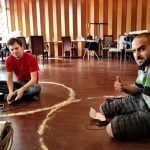Every once in a while, I’m intrigued by a Flash Fiction challenge on Chuck Wendig’s blog. So this week, you had to pick random elements by dice roll from his lists to make your story. I managed to pull:
- Alternate History
- Dying Earth
- A locked door
- A perilous journey
So all these together had me create “Uncle Henry’s Study” – enjoy!
Mother packed my suitcase before dawn. There was only room for a few things, so she wouldn’t let me choose. She selected blouses and stockings, skirts and even a pair of knickers I wore for gardening. She put in an extra pair of sensible shoes. “There will be no need for patent leather, I think,” she said thoughtfully, and set aside my Sunday best. She packed my best sweater too and brought down my thick woolen coat.
“It will be cold,” she explained, “where you’ll be going.”
I sat at the edge of my bed, still in my pajamas.
“Tell me again,” I whispered. The pre-dawn darkness made me unwilling to disturb the silence. “Tell me again what it’ll be like.”
Mother stopped packing and sat beside me. She was a refined woman before the war started, the daughter of an army colonel who grew up near Kensington Gardens in London. She had met my father at a military luncheon and chose to be a lieutenant’s wife, breaking my grandfather’s heart. Grandfather was cavalry once upon a time; my father, so thoroughly modern, was in the Royal Air Corp, far away now at war.
Mother smoothed down her skirt. “It will be cold,” she repeated, “and very dark. That is what we’ve been told. I cannot tell you more except that. It’s all a bit of a mystery.”
I didn’t want to think of the cold. England could be cold, of course, but the way she said it you’d think I was going to the Arctic Circle itself. Perhaps I was. Nobody would tell me.
I shook my head then. “I don’t see why you can’t come with me.”
My mother squeezed my hand. “We’ve been over this, dove. During the blitz, the order is to evacuate only children. Perhaps I’ll be able to follow after.” She stood up then and walked to the door. “There’s enough room for you to pick one special belonging and bring it with you. Just one. Change your clothes and bring your things downstairs.” Her voice thickened for a moment. “And don’t forget extra socks. There should be some in the cupboard.”
Once she was gone, I stared around my room. What did one bring when you were abandoning home during war? We were not as wealthy as grandfather but I didn’t lack for belongings, each with their own memory.
I dressed first as a way to drag the process out. I knew that I should pick something adult, something I could grow with and grow into. Who knew when I would return, or what would be left when I did? I remembered the bombed out buildings in town, the craters where someone’s life had once been. I thought about my china tea pot smashed as an explosion flattened our home, or my dance shoes burned in the raging fire afterwards. I wanted to save it all.
Instead, I chose the smallest of things. It was an old fountain pen, passed down from my grandmother to my mother and to me. It was ornately decorated with swirling leaves around an ivory body. It was easily the smallest but most precious thing I owned. It slipped easily into the pocket of my coat. This way, I could fit more socks.
I finished dressing and tiptoed, coat over my arm, downstairs. I could hear mother talking with Uncle Henry in the foyer. Uncle Henry worked for the Royal Applied Sciences Division, whatever that meant. It was Uncle Henry who brought home the gas masks when the Germans had dropped poison on London. It was Uncle Henry who brought home the radiation pills just before we had evacuated the city to the house here in Kent. We were some of the only people to have them when the Bomb flattened London, so many miles away. I remember the words he said after the screams on the radio died in a hail of static. Nuclear, they said.
“They are death,” he had intoned, “all of them. They have destroyed the world.”
Now he stood, his hands clasped behind him, at the bottom of the stairs.
“If the others knew we were sending her, instead of Norton’s children,” Uncle Henry was saying, “he’d have a screaming fit. But she’s the one, Helen. Your little girl will survive this.”
“Is there no chance for the rest of us?” Mother asked.
Uncle Henry’s face fell then. “It’s hard to say. But the Germans have deployed their Thul Society men with some kind of poison in the water. It’s only a matter of time. Their top madman wants nothing but to end it all. And it’s happening soon.”
I leaned forward, my breath caught. The end? The stair under my foot creaked and Uncle Henry looked up. His smile was gentle.
“Lucy,” he said quietly, “I suppose you heard.”
I didn’t answer, but threw myself into Mother’s arms.
“I won’t go,” I said fiercely.
Mother took my chin in her hands. “You will,” she pressed. She looked over her shoulder then, at the door just under the stairs. It had been locked as long as I’d been in the Kent House. It was Uncle Henry’s study and we’d been forbidden to try and get in. I had been horribly curious, but now my knees grew weak.
Upstairs, I heard feet thump on a hallway riser. All three of us froze.
“Bollocks,” Uncle Henry exclaimed, “Norton’s awake.” He took my hand then and tugged me down the hall. “We have to go, Lucy. Now!”
“Mother!” I exclaimed.
Uncle Henry pulled me from her arms so hard I nearly dropped my suitcase. He produced a brass key from his pocket and lead me to the locked door, thrusting the key into the lock. Upstairs I could hear angry voices and feet approaching on the stairs. My heart thudded in my chest and I heard in my ears again: she’s the one. Your little girl will survive this.
The key turned in the lock; I looked back one last time. My mother, ever the lady, stood poised at the foot of the stairs. “Remember your socks,” she called after me, “it will be cold!”
But as Uncle Henry opened the door, I heard her whisper, “I love you, dove.” And I was forever glad that those were her last words to me, and not some nonsense about the weather.
By: Shoshana Kessock – June 27, 2013















